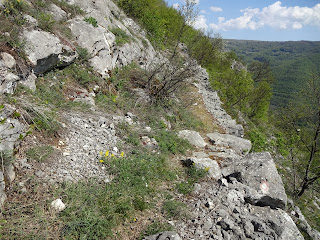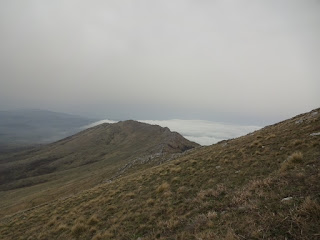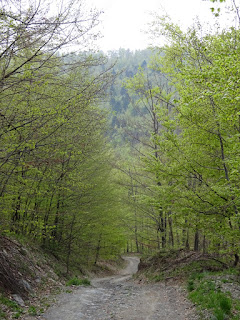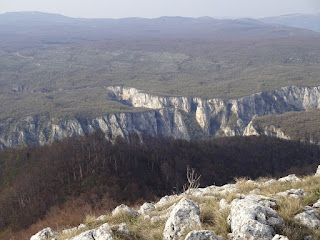Serbia south of Belgrade is very different to the Serbian province of Vojvodina north of Belgrade. Vojvodina is flat, has large fields of crops, and a strong Hungarian influence. The script is largely Latin. I have written about it earlier in my blog.
Apart from the flood plains of rivers, Southern Serbia is hilly or mountainous, the hill farms seem to cover a smaller area than those in Voyvodina, they generally have a few sheep, chickens, maybe goats or cows, a small field of maize, an orchard or a vineyard, not very specialized unlike the large arable farms in Vojvodina. The script is generally Cyrillic. In Southern Serbia there was a strong sense of rural depopulation, people leaving for jobs in Belgrade, Germany or Austria, leaving empty houses, some renovated and awaiting their return at a later stage in their lives. Those left are the elderly. As they die so their houses can become left to decay. The higher, more distant fields are no longer farmed and become covered with thorny, often impenetrable scrub, along with the tracks connecting them.
I have walked through some magnificent landscape in Southern Serbia. Many Serbian mountain groups make day visits to the great mountains and valleys such as Veliki Strbac, Rtanj and Babin Zub. However, long distance footpaths have not historically been a feature in Serbia; the E4, and it's sister the E7 are two created as a result of a European initiative (along with the Sultan's trail), and their development has been limited with, for example, no GPS files of the route being released, something that could be achieved at little cost. Walking alone is also something which surprises people here ("Sam?" I was asked in surprised tones). There is a lot of potential for more people to enjoy these paths if they were better known, not only is there landscapes to admire, there are also various historic and religious places of interest. The fortresses of Smederevo, Golubac, Ram and Sokobanya come to mind, and the monasteries of Tumane, Vratna and Bukovo. Natural phenomena range from the limestone bridges of Vratna canjon, to disappearing rivers or river sources such as Krupajsko Vrelo, there are caves a plenty, for example Ravništarka Pećina and canyons like the Lazarev gorge. Of mountains there is no shortage, from Beljanica to the view of the Iron Gates of the Danube, from Avala to the Stara Planina. Then there is the food, especially the Serbian cuisine offered at some of the private accommodation, along with a warming glass of rakia. For those of an engineering background such as myself places like Majdanpek and the Djerdap dam are fascinating. Clearly lots of reasons to walk through the southern part of Serbia.
The E4, as I have followed it in "Rambling through Serbia", is annoying in places, with some huge meanders to see particular locations, while obscurely avoiding major places like Negotin. The details of the route are also lacking and I hope the GPS files that I have linked to my blog will help others who follow in my footsteps. They were based on finding routes on Google Earth and various maps that seemed to match the trails marked on the small scale maps in "Rambling through Serbia". The maps I used included two GPS maps, Garmin's Adria and Navitrack's Balkan topographic maps, and maps copied from Tourist Information internet sites, the Djerdap Park map was especially useful. For gaining a general impression I bought the larger scale Freytag maps of North and South Serbia. There are detailed maps made by the Military Geographical Institute, but I had no response to my e-mail asking to buy copies. The Stara Planina and Suva Planina hiking maps, which can be purchased online, were also useful. However as rural depopulation occurs, some of the tracks on even the best maps, and on which the E4 relies, are becoming overgrown and will soon become impassable unless someone has responsibility for keeping them clear.
Accommodation is an issue and forced me to do more wild camping than I would like (although I had some beautiful mountain top campsites that I would not have wanted to miss). It helps enormously if places are on booking.com or some similar booking site that does not require a knowledge of Serbian, however there are many areas where lodgings are not covered by online reservation including some large hotels. There is private, bread and breakfast type accommodation listed on tourist association websites which covers many places the E4 passes through, but to stay at these you have to telephone. They are unlikely to speak English which is a problem. I had the additional problem that my phone with a British EE sim card would not connect with Serbian mobile phones. It is also no good just turning up at private accommodation, all you will find is a sign with a telephone number. On occasion I asked an English speaking receptionist or owner of the place I was staying at to ring ahead and book the next night's accommodation. With the notable exception of Zrenjamin, most tourist information offices will not book or even find details of accommodation outside their own municipalities (and often I found the Tourist Information offices closed).
I hope more people will follow in my footsteps, such people bring money into rural areas, and foreign visitors bring money into Serbia, which can only help limit the decline of rural communities. When to visit is something to consider. At the end of March I had snow and my water bottle started to freeze but just a few weeks later in April sweat was dripping off my nose as I climbed with the sun shining above me! Temperatures were however very pleasant for my trip in September and October of 2017. Many places were not open for the season until May 1.
The main negative to walking through Serbia are dogs. They bark at you as you walk through villages, fortunately most cannot reach you due to fences or chains, but there are loose dogs that come at you barking and baring their teeth. Serbia is a high risk country for rabies so a bite from a loose dog is potentially deadly and urgent medical attention is advised.
In general Serbians look pretty solemn as you pass them, just like the paintings on the walls of the churches. This and the barking dogs might make you feel unwelcome. This is not the case. Most of the Serbians I have spoken to are very friendly, many are curious, some even inviting me into their houses for a coffee or a rakia. A cheery "Dober Dan" (good day) does a lot to help break the ice, and even bring a smile to the face of an 80 year old lady dressed in black.
A final point - Serbian dinars are hard to change outside Serbia, there are a number of exchange places just before the border with Bulgaria, you might try there as I found nothing after the border.
Srećan Put!
For the start of my blog of walking through Serbia click here.
My journey continues in Bulgaria see johnpone4bulgaria.blogspot.com.
Update: the Mountaineering Association of Serbia now has a site for the E4 and E7, also see Rolf Gerstendorf website for the E8, he plans to follow part of the E4 in Serbia to fill in a gap in this trail.
Further Update: Based on my travels on the E4 I have written a book "Six Pairs of Boots: Spain to Cyprus on the E4 Trail" by John Pucknell available from Amazon.co.uk, Amazon.com, the Bookdepository.com, lehmanns.de, bookspot.nl, and other good online bookstores.
Another Update: As of October 2022, large sections of the E4 in Serbia are now available as gpx files from Traildino.com. OutdoorActive also has many parts of the Serbian E4 on its hiking layer in the maps on its App.
 |
| Me and my rucksack |




































